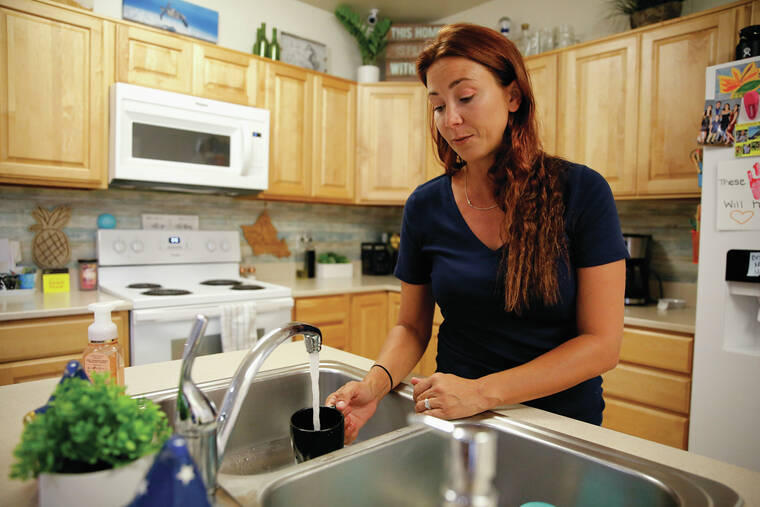Distrust remains after Navy report on tainted Hawaii water
HONOLULU — Lauren Wright continues to be leery of the water coming out of the taps in her family’s U.S. Navy home in Hawaii, saying she doesn’t trust that it’s safe.
Wright, her sailor husband and their three children ages 8 to 17 were among the thousands of people who were sickened late last year after fuel from military storage tanks leaked into Pearl Harbor’s tap water.
ADVERTISING
The family has returned to their military housing after spending months in Honolulu hotels, but they continue taking safety measures including taking short, five-minute showers. They don’t drink their tap water or cook with it.
A Navy investigation released Thursday blamed the fuel leak and the water crisis that followed on shoddy management and human error. Some Hawaii residents, including Native Hawaiians, officials and military families said the report doesn’t help restore trust in the Navy.
“I was at least hoping for some sort of remorse for the families and everybody involved in this,” Wright said.
She said the ordeal has changed her view on the military from a decade ago when her husband first joined.
“I was the proud Navy spouse, you know, stickers and T-shirts,” she said. “I feel like the Navy has failed at what they promised every service member. They failed at a lot of things. And I’m not so proud.”
It’s difficult to trust the Navy partly because Hawaii residents and officials for years have questioned the safety of the giant fuel storage tanks that have sat above an important aquifer since World War II, said Kamanamaikalani Beamer, a former trustee of the Commission on Water Resource Management.
“Releasing a report saying that they were lying to us is not a step towards building trust,” he said. “De-fueling and getting the tanks out permanently, setting aside funds to remediate the water systems all across Oahu and replant our forests — when I see steps like that happening — that’s a tangible step toward rebuilding trust.”
Some Native Hawaiians said the report only deepened a distrust in the military that dates to at least 1893, when a group of American businessmen, with support from U.S. Marines, overthrew the Hawaiian kingdom. More recently, Native Hawaiians fought to stop target practice bombing on the island of Kahoolawe and at Makua Valley in west Oahu.
“There’s no proof I should have faith in them,” said Kalehua Krug, with Ka’ohewai, a cultural organization advocating for a clean aquifer for Oahu. “They’ve done nothing but lie for generations.”
Navy officials have said previously they have a lot of work ahead to gain the trust of communities across the island, and in particular Native Hawaiians.
The investigation report released Thursday listed a cascading series of mistakes from May 6, 2021, when operator error caused a pipe to rupture and 21,000 gallons (80,000 liters) of fuel to spill when it was being transferred between tanks. Most of the fuel spilled into a fire suppression line and sat there for six months, causing the line to sag. A cart rammed into this sagging line on Nov. 20, releasing 20,000 gallons (75,700 liters) of fuel.
The report said officials defaulted to assuming the best about what was happening when the spills occurred, instead of assuming the worst, and this contributed to their overlooking the severity of situation.
The spill contaminated the Navy’s water system. Fuel didn’t get into the Honolulu municipal water supply. But concerns the oil might migrate through the aquifer and get into the city’s wells prompted the Honolulu Board of Water Supply in December to shut down a key well serving some 400,000 people. The agency has been asking residents to conserve water because of this and unusually dry weather.
The tanks continue to pose a threat to Oahu’s drinking water while they hold fuel, said Ernest Lau, manager and chief engineer of the water utility.
The report saying it will take more than two years to drain the facility is concerning, Lau said Friday.


